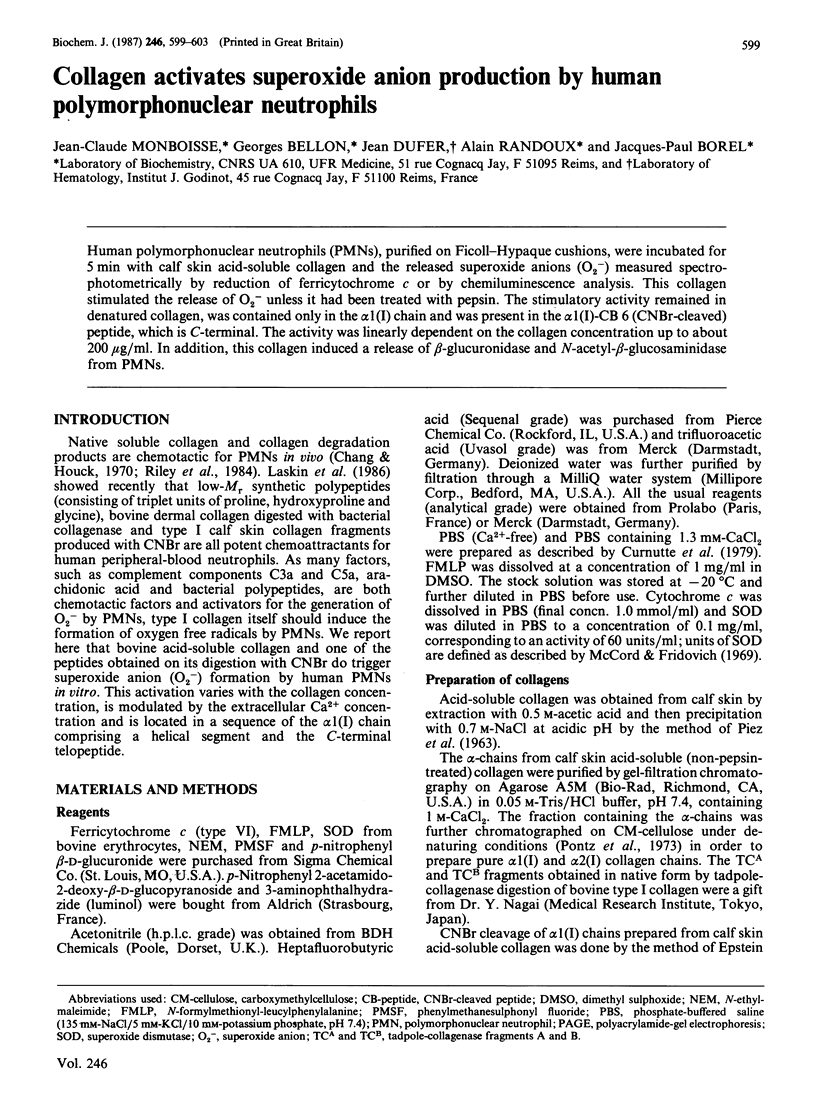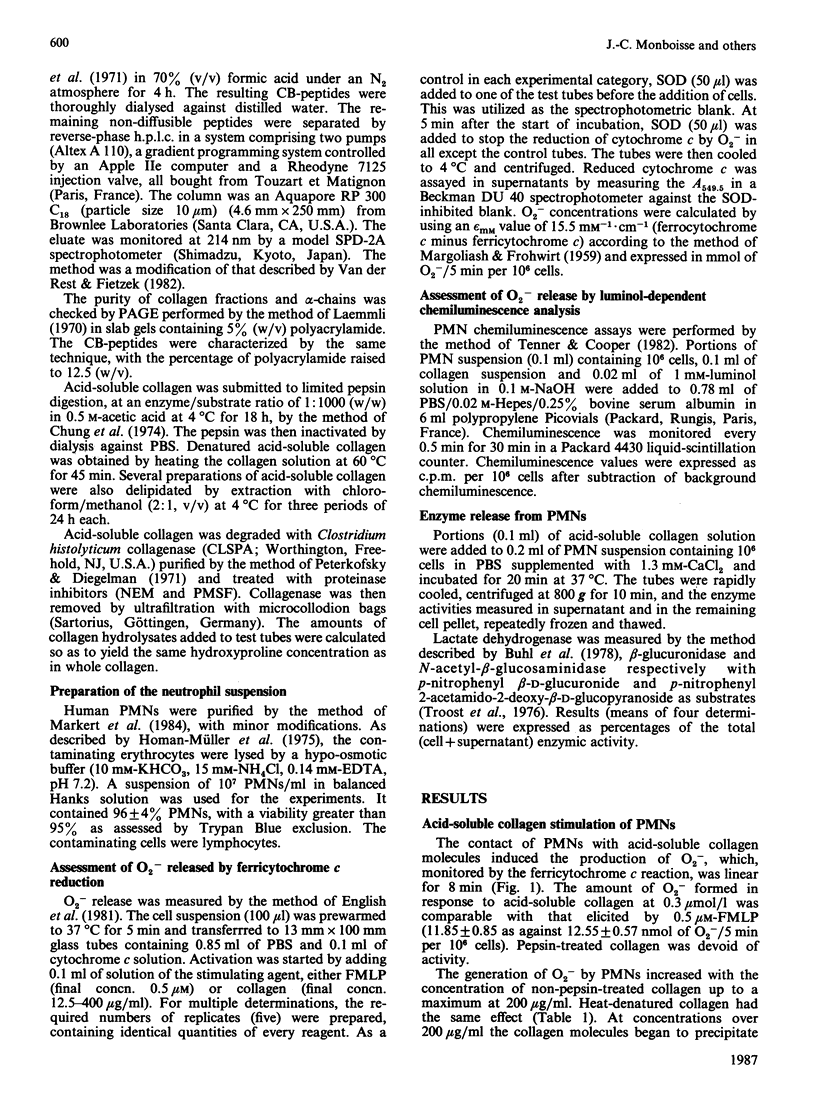Abstract
Human polymorphonuclear neutrophils (PMNs), purified on Ficoll-Hypaque cushions, were incubated for 5 min with calf skin acid-soluble collagen and the released superoxide anions (O2-) measured spectrophotometrically by reduction of ferricytochrome c or by chemiluminescence analysis. This collagen stimulated the release of O2- unless it had been treated with pepsin. The stimulatory activity remained in denatured collagen, was contained only in the alpha 1(I) chain and was present in the alpha 1(I)-CB 6 (CNBr-cleaved) peptide, which is C-terminal. The activity was linearly dependent on the collagen concentration up to about 200 micrograms/ml. In addition, this collagen induced a release of beta-glucuronidase and N-acetyl-beta-glucosaminidase from PMNs.
Full text
PDF




Images in this article
Selected References
These references are in PubMed. This may not be the complete list of references from this article.
- Buhl S. N., Jackson K. Y., Graffunder B. Optimal reaction conditions for assaying human lactate dehydrogenase pyruvate-to-lactate at 25, 30, and 37 degrees C. Clin Chem. 1978 Feb;24(2):261–266. [PubMed] [Google Scholar]
- Chang C., Houck J. C. Demonstration of the chemotactic properties of collagen. Proc Soc Exp Biol Med. 1970 May;134(1):22–26. doi: 10.3181/00379727-134-34719. [DOI] [PubMed] [Google Scholar]
- Chung E., Keele E. M., Miller E. J. Isolation and characterization of the cyanogen bromide peptides from the alpha 1(3) chain of human collagen. Biochemistry. 1974 Aug 13;13(17):3459–3464. doi: 10.1021/bi00714a006. [DOI] [PubMed] [Google Scholar]
- Curnutte J. T., Babior B. M., Karnovsky M. L. Fluoride-mediated activation of the respiratory burst in human neutrophils. A reversible process. J Clin Invest. 1979 Apr;63(4):637–647. doi: 10.1172/JCI109346. [DOI] [PMC free article] [PubMed] [Google Scholar]
- English D., Roloff J. S., Lukens J. N. Regulation of human polymorphonuclear leukocyte superoxide release by cellular responses to chemotactic peptides. J Immunol. 1981 Jan;126(1):165–171. [PubMed] [Google Scholar]
- Epstein E. H., Jr, Scott R. D., Miller E. J., Piez K. A. Isolation and characterization of the peptides derived from soluble human and baboon skin collagen after cyanogen bromide cleavage. J Biol Chem. 1971 Mar 25;246(6):1718–1724. [PubMed] [Google Scholar]
- Fauvel F., Legrand Y. J., Caen J. P. Platelet adhesion to type I collagen and alpha 1 (I)3 trimers: involvement of the C-terminal alpha 1 (I) CB6A peptide. Thromb Res. 1978 Feb;12(2):273–285. doi: 10.1016/0049-3848(78)90298-0. [DOI] [PubMed] [Google Scholar]
- Hoffstein S. T., Gennaro D. E., Manzi R. M. Surface contact inhibits neutrophil superoxide generation induced by soluble stimuli. Lab Invest. 1985 May;52(5):515–522. [PubMed] [Google Scholar]
- Homan-Müller J. W., Weening R. S., Roos D. Production of hydrogen peroxide by phagocytizing human granulocytes. J Lab Clin Med. 1975 Feb;85(2):198–207. [PubMed] [Google Scholar]
- Laemmli U. K. Cleavage of structural proteins during the assembly of the head of bacteriophage T4. Nature. 1970 Aug 15;227(5259):680–685. doi: 10.1038/227680a0. [DOI] [PubMed] [Google Scholar]
- Laskin D. L., Kimura T., Sakakibara S., Riley D. J., Berg R. A. Chemotactic activity of collagen-like polypeptides for human peripheral blood neutrophils. J Leukoc Biol. 1986 Mar;39(3):255–266. doi: 10.1002/jlb.39.3.255. [DOI] [PubMed] [Google Scholar]
- MARGOLIASH E., FROHWIRT N. Spectrum of horse-heart cytochrome c. Biochem J. 1959 Mar;71(3):570–572. doi: 10.1042/bj0710570. [DOI] [PMC free article] [PubMed] [Google Scholar]
- Markert M., Andrews P. C., Babior B. M. Measurement of O2- production by human neutrophils. The preparation and assay of NADPH oxidase-containing particles from human neutrophils. Methods Enzymol. 1984;105:358–365. doi: 10.1016/s0076-6879(84)05048-5. [DOI] [PubMed] [Google Scholar]
- McCord J. M., Fridovich I. Superoxide dismutase. An enzymic function for erythrocuprein (hemocuprein). J Biol Chem. 1969 Nov 25;244(22):6049–6055. [PubMed] [Google Scholar]
- Peterkofsky B., Diegelmann R. Use of a mixture of proteinase-free collagenases for the specific assay of radioactive collagen in the presence of other proteins. Biochemistry. 1971 Mar 16;10(6):988–994. doi: 10.1021/bi00782a009. [DOI] [PubMed] [Google Scholar]
- Pontz B. F., Müller P. K., Meigel W. N. A study on the conversion of procollagen. Release and recovery of procollagen peptides in the culture medium. J Biol Chem. 1973 Nov 10;248(21):7558–7564. [PubMed] [Google Scholar]
- Tenner A. J., Cooper N. R. Stimulation of a human polymorphonuclear leukocyte oxidative response by the C1q subunit of the first complement component. J Immunol. 1982 Jun;128(6):2547–2552. [PubMed] [Google Scholar]
- Troost J., van der Heijden M. C., Staal G. E. Characterization of alpha-L-fucosidase from two different families with fucosidosis. Clin Chim Acta. 1976 Dec 1;73(2):329–346. doi: 10.1016/0009-8981(76)90180-7. [DOI] [PubMed] [Google Scholar]
- van der Rest M., Fietzek P. P. A comprehensive approach to the study of collagen primary structure based on high-performance liquid chromatography. Eur J Biochem. 1982 Jul;125(3):491–496. doi: 10.1111/j.1432-1033.1982.tb06709.x. [DOI] [PubMed] [Google Scholar]



